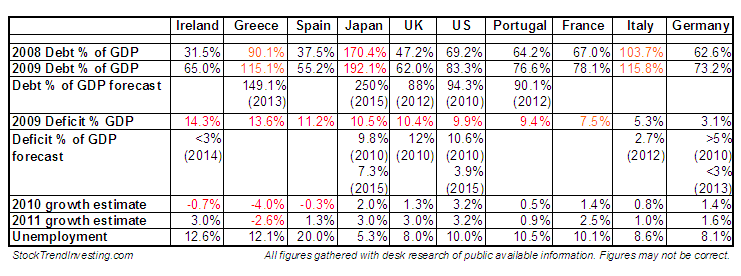Debt or Deficit: are we into trouble compared to other countries?

Why do certain countries with large public debts get into financing problems while others with similar or higher debts continue to live life as usual? A debt crisis seems to unfold itself in Europe. Japanese debt is increasing soon to more than 200% of GDP. US debt is on the rise as well.
In a previous article we have seen that US public debt is rising to unprecedented heights at this moment. But how does this debt level compare to other countries? And will the debt crisis infect the US, UK, Japan and other European markets?
Debt versus Deficit & Growth
The table above compares the public debt and public deficit as a percentage of GDP for a number of countries that is regular in the news with regards to the debt crisis.
Greece is in crisis. Portugal, Spain and Ireland are part of the so called PIGS countries and are seen as potential next victims. France and the UK are sometimes seen as the next in line while Italy has a huge public debt but is not mentioned often to be severely at risk. Germany is said not to stimulate the economy enough while Japan’s debt has already gone through the roof but it seems to be doing OK with it.
The table above shows, besides the public debt and deficit numbers, also the expected economic growth for 2010 and 2011 and current unemployment level by country.
Our 3 conclusions:
- Just a high public debt as a percentage of GDP seems not to be the reason why countries get into financing problems.
- Countries seem to get financing troubles when there is a negative outlook for the economic growth in combination with a high public deficit.
- Maybe there is no “debt crisis”. A more suitable term is that some countries face a “growth and deficit crisis”. A crisis in refinancing the debt is just the symptom.
Where to worry
Countries with a lower projected economic growth should be more careful with the debt they take on. They cannot grow themselves out of their debts. That would happen when debt as percentage of GDP falls, not because the debt is reduced in absolute terms but because the economy is growing faster than the debt.
The important aspect of the deficit is to recognize which part of the deficit is structural and which part is caused by temporary economic stimulus or rescue packages.
Deficits in 2009 for the UK and US could very well be caused for a large part by the economic stimulus and rescue packages while for Greece it could be much more a structural problem.
Looking at our limited analysis, we would not be too worried about the US, UK, Germany or even Italy for example. The other European countries listed here have to come with reliable plans and show that they can reduce their structural deficits.
Japan is a weird nut. Often it is claimed that Japan can live with the high debt percentage because most of it is financed within Japan. But growth projections are probably only rather high for the coming years because the recession was so deep. Future growth will be substantially limited because of Japan’s demographics. And the deficit does not seem to come down very much in the coming years. I would be very careful here.
What shall governments do now?
So, what do we think that countries need to do now?
- Get as soon as possible to a public budget that in normal economic times is balanced with a deficit that falls below international accepted levels and below the economic growth (the Euro zone target is for example a maximum 3% deficit).
- Take into account in these balanced budget calculations and measures that interest rates may increase in the future and that economic growth may disappoint.
- Stimulate the economy at this moment with temporary and effective public investments that are large enough to keep the economy growing but that are not too big to cause debts for which the financing costs are too high to fit into the needed balanced budget after the stimulus packages are spent.
Thus, we encourage the governments to take action now to lower public spending structurally and/or increase its revenues to have a clear outlook on a balanced budget within a few years. Such a budget needs to take into account the financing costs of the public debt including the debt taken on to stimulate the economy now. And it should be based on conservative economic growth numbers and increasing interest rates.
It seems to be internationally accepted that debt levels in the developed world are increasing to unprecedented heights. However, only countries who keep their deficit under control and who manage to keep growing can do so without risking a financing crisis.
We would recommend any private investor who wants to invest in public bonds or treasuries, to keep a close eye on the projected deficit and growth levels for the countries they want to buy the bonds from. A slightly higher return on investment is not that attractive when the return of investment comes into question.
In another article we will look into the projections that are made for the increase in debt levels for the developed and developing countries and what that may mean for investors.
Read Our Other Popular Posts on the Economy
- Why is the Japanese Yen so Strong
- Factors contributing to Economic Growth and Causes for Recession and Economic Crisis
- History of US federal debt as percentage of GDP: Why is this now important?
- Why is China Facing Inflation?
Next & Previous Blog Post
- ‹ previous
- 39 of 174
- next ›


